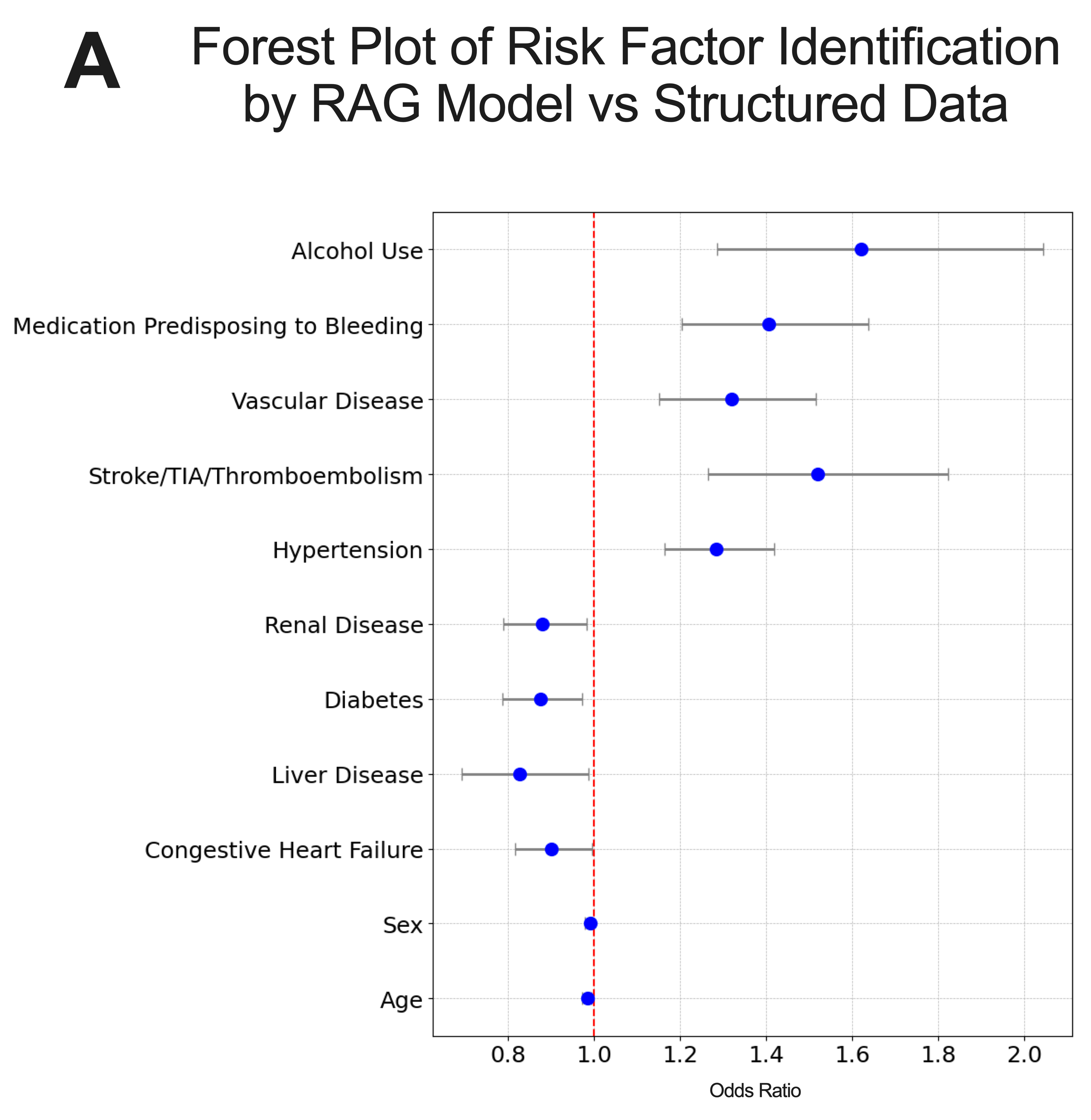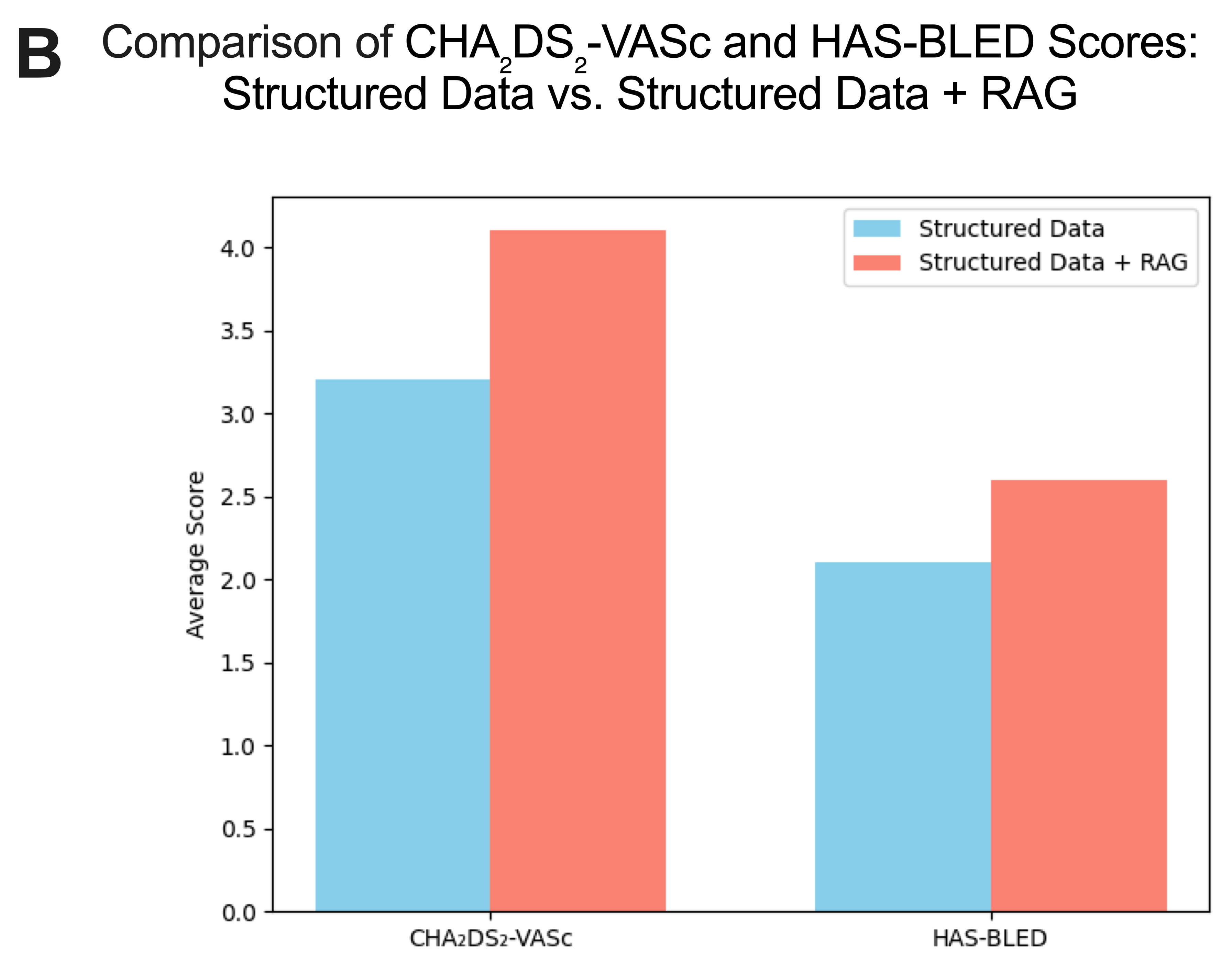Final ID: MDP1054
Retrieval-Augmented Generation for Extracting CHADS-VASc and HAS-BLED Risk Factors from Unstructured Clinical Notes in Patients with Atrial Fibrillation
Abstract Body (Do not enter title and authors here): Background: Assessment of stroke and bleeding risk in patients with atrial fibrillation (AF) is crucial for guiding anticoagulation therapy. CHADS-VASc and HAS-BLED are widely used scores for defining these risks, but current assessments rely on manual calculation by clinicians or approximations from structured EHR data elements. Unstructured clinical notes contain rich information that could enhance risk assessment. We developed and validated a Retrieval-Augmented Generation (RAG) approach to extract CHADS-VASc and HAS-BLED risk factors from unstructured notes in patients with AF.
Methods: We employed a RAG architecture paired with the large language model, Llama3, to extract features relevant to CHADS-VASc and HAS-BLED scores from unstructured notes. The model was deployed on a random set of 1,00 clinical notes (416 AF patients) from Yale New Haven Hospital. To establish a gold standard, 2 clinicians manually reviewed and labeled CHADS-VASc and HAS-BLED risk factors in a random subset of 200 notes. The CHADS-VASc and HAS-BLED scores were calculated for each patient using structured data alone and by incorporating risk factors identified with RAG. We assessed performance across risk factors using macro-averaged area under the receiver operating characteristic (AUROC).
Results: The RAG model demonstrated robust performance in extracting risk factors from clinical notes. In the 1000 clinical notes, RAG identified several risk factors more frequently than structured elements, including hypertension (59.7% vs 46.6%), stroke (19.2% vs 12.7%), vascular disease (35.6% vs 27.2%), diabetes (33.9% vs 27.8%), medication usage predisposing to bleeding (29.1% vs 20.9%), and alcohol use (14.4% vs 8.9%). The RAG approach achieved an accuracy of 91% and macro-AUROC of 0.88, significantly outperforming structured data (accuracy 78%, macro-AUROC 0.76) in 200 expert annotated notes. Incorporating risk factors identified by RAG increased both CHADS-VASc and HAS-BLED scores compared with using structured data, with the mean CHADS-VASc score increasing from 3.3 ± 1.9 using structured data to 4.2 ± 2.1 with RAG. Similarly, the mean HAS-BLED score increased from 2.2 ± 1.3 to 2.7 ± 1.5.
Conclusion: An LLM-optimized RAG can accurately extract CHADS-VASc and HAS-BLED risk factors from unstructured clinical notes in AF patients. This approach can enable computable risk assessment and guide appropriate anticoagulation therapy.
Methods: We employed a RAG architecture paired with the large language model, Llama3, to extract features relevant to CHADS-VASc and HAS-BLED scores from unstructured notes. The model was deployed on a random set of 1,00 clinical notes (416 AF patients) from Yale New Haven Hospital. To establish a gold standard, 2 clinicians manually reviewed and labeled CHADS-VASc and HAS-BLED risk factors in a random subset of 200 notes. The CHADS-VASc and HAS-BLED scores were calculated for each patient using structured data alone and by incorporating risk factors identified with RAG. We assessed performance across risk factors using macro-averaged area under the receiver operating characteristic (AUROC).
Results: The RAG model demonstrated robust performance in extracting risk factors from clinical notes. In the 1000 clinical notes, RAG identified several risk factors more frequently than structured elements, including hypertension (59.7% vs 46.6%), stroke (19.2% vs 12.7%), vascular disease (35.6% vs 27.2%), diabetes (33.9% vs 27.8%), medication usage predisposing to bleeding (29.1% vs 20.9%), and alcohol use (14.4% vs 8.9%). The RAG approach achieved an accuracy of 91% and macro-AUROC of 0.88, significantly outperforming structured data (accuracy 78%, macro-AUROC 0.76) in 200 expert annotated notes. Incorporating risk factors identified by RAG increased both CHADS-VASc and HAS-BLED scores compared with using structured data, with the mean CHADS-VASc score increasing from 3.3 ± 1.9 using structured data to 4.2 ± 2.1 with RAG. Similarly, the mean HAS-BLED score increased from 2.2 ± 1.3 to 2.7 ± 1.5.
Conclusion: An LLM-optimized RAG can accurately extract CHADS-VASc and HAS-BLED risk factors from unstructured clinical notes in AF patients. This approach can enable computable risk assessment and guide appropriate anticoagulation therapy.
More abstracts on this topic:
A Cross-scale Causal Machine Learning Framework Pinpoints Mgl2+ Macrophage Orchestrators of Balanced Arterial Growth
Han Jonghyeuk, Kong Dasom, Schwarz Erica, Takaesu Felipe, Humphrey Jay, Park Hyun-ji, Davis Michael E
Association Between Exposure to Toxic Release Inventory Facilities and Hypertrophic Cardiomyopathy Prevalence in MarylandMohammadiarvejeh Parvin, Maron Martin, Maron Brad, Kshetry Pratima, Ennett Colleen, Rowin Ethan, Prohl Anna, Mccoy Rozalina, Huang Shuo Jim, Brooks Ian, Chen Shuo


